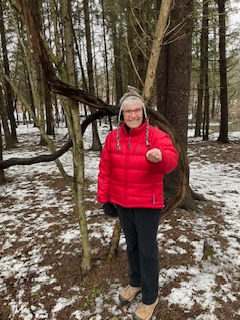World on the Move!
- dhiker247
- Jan 23
- 3 min read

Animals move to different locations for a time and then move back. What’s that called again? The Chickadees migrated to Harrington today and next week they will be back at the farm. I hope you had a great flight and your stay was 4-stars.

When the weather is cold you have to keep moving. As animals move they leave tracks behind whether it is mud, sand or snow and there was lots of snow at Harrington. The tracks or even wing prints they leave behind are just a couple of the signs an animal has crossed your path. What are some other signs that animals leave behind? Put on your detective toque, neck tube or scarf, snowsuit, boots and gloves and get outside and explore. Did you see any signs of animals today?

Travelling as a Deer Trail is a safe way to travel alongside roads for Nature Mentors and students. It is also a smart way deer travel in winter to keep the snow packed to make it easier to travel and faster. Watch out for deer trails in your travels!

We found our nature animals and tracks from animals while travelling to Mystery Forest. Could you tell what the animals were doing?
We made some of our own tracks in Mystery Forest. What did you do?
Even inside the hall, we kept moving. Coyote led us in a tricky action game? What is that game called? It’s fun and there was a little competition for a GOAT T-Shirt. Acorn and Chickadee were equal in their skills and concentration but in the end Acorn won. We also travelled together as Team Chickadee walking around the hall with cheers and smiles.
Using our nature names we played a game of charades. Was it hard for you to think of how different animals move and their behaviour? What about the acting made it easy or hard to guess the animal or acorn? Maybe you could try working on how your animal moves and some of their behaviours for next week?
In the wild animals walk in some interesting patterns? Some of these movements can be difficult for humans to do. Perfect Walkers, Waddlers, Bounders and Hoppers. Which movement was easy? Hard? Can you remember the name of one animal that moves for each of these ways?
Sometimes we can miss what happens outside because the animal moves so fast. It would be nice to slowing movement down. Thanks to Acorn, Frog and Salmon for their idea of Slow Motion Tag! It was a great idea for an indoor activity.

Some animals slow down so much that they go into what is called torpor or even hibernation. What is the difference? Nature friends also had a moment of hibernation or maybe it was torpor?
In the cold weather, we saw and heard some birds but they quickly flew away as soon as we started tobogganing. Sliding is another way that animals can move and it can be a fast way to escape from being eaten.
We also practiced sliding inside.

Did you know that when boiling water is thrown into freezing air, it turns into a white cloud of steam and ice crystals? This is because the water evaporates quickly and condenses into tiny droplets, which then freeze. Please do not try this at home unless you have help from your parents.
A Naturalist always takes a moment to write some notes down and maybe even sketch a picture. It can be tough to try and put it all down on paper or even a blog. What did you write or draw in your nature notebook?
Our indoor campfire was the perfect place to share our nature notebooks and stories from our adventure in Harrington. Enjoy sharing at home!
Thanks to the parents for your flexibility to ensure safe travels to Harrington. Special thanks to the Nature Mentors Tamarack, Daisy and Raccoon. It's so great to have Dragonfly step in and we'll get to see Beaver back at farm for a visit next week.





































































































Ingin bermain slot gacor online mudah menang? situs zodiakslot adalah solusinya, sebagai agen slot resmi gampang maxwin 2025, kami memastikan kemenangan ada di depan mata! ayo raih cuan bersama mesin slot gacor online terpercaya.